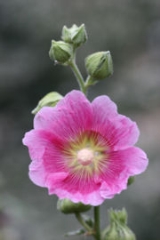
Alcea rosea
Encyclopedia
Alcea rosea is an ornamental plant
in the Malvaceae
family
.
It was imported into Europe
from southwestern China during, or possibly before, the 15th century. William Turner, an herbalist
of the time, gave it the name "holyoke" from which the English name derives.
(having a two-year life cycle), as an annual
, or as a short-lived perennial. It frequently self-sows, which may create a perception that the plants are perennial. The plant may flower during its first year when sown early. It will grow in a wide range of soils, and can easily reach a height of about 8 ft. The flowers are a range of colours from white to dark red, including pink, yellow and orange. Different colours prefer different soils. The darker red variety seems to favour sandy soils, while the lighter colour seems to favour clay soils. The plants are easily grown from seed, and readily self-seed. However, tender plants, whether young from seed or from old stock, may be wiped out by slugs and snails. The foliage is subject to attack from rust
(Puccinia malvacearum
), which may be treated with fungicide
s. Commercial growers have reported that some closely related species (Alcea rugosa and Alcea ficifolia) are resistant to this fungus.
. It is used to control inflammation
, to stop bedwetting
and as a mouthwash in cases of bleeding gums.

Ornamental plant
Ornamental plants are plants that are grown for decorative purposes in gardens and landscape design projects, as house plants, for cut flowers and specimen display...
in the Malvaceae
Malvaceae
Malvaceae, or the mallow family, is a family of flowering plants containing over 200 genera with close to 2,300 species. Judd & al. Well known members of this family include okra, jute and cacao...
family
Family (biology)
In biological classification, family is* a taxonomic rank. Other well-known ranks are life, domain, kingdom, phylum, class, order, genus, and species, with family fitting between order and genus. As for the other well-known ranks, there is the option of an immediately lower rank, indicated by the...
.
It was imported into Europe
Europe
Europe is, by convention, one of the world's seven continents. Comprising the westernmost peninsula of Eurasia, Europe is generally 'divided' from Asia to its east by the watershed divides of the Ural and Caucasus Mountains, the Ural River, the Caspian and Black Seas, and the waterways connecting...
from southwestern China during, or possibly before, the 15th century. William Turner, an herbalist
Herbalist
An herbalist is:#A person whose life is dedicated to the economic or medicinal uses of plants.#One skilled in the harvesting and collection of medicinal plants ....
of the time, gave it the name "holyoke" from which the English name derives.
Cultivation
Alcea rosea is variously described as a biennialBiennial plant
A biennial plant is a flowering plant that takes two years to complete its biological lifecycle. In the first year the plant grows leaves, stems, and roots , then it enters a period of dormancy over the colder months. Usually the stem remains very short and the leaves are low to the ground, forming...
(having a two-year life cycle), as an annual
Annual plant
An annual plant is a plant that usually germinates, flowers, and dies in a year or season. True annuals will only live longer than a year if they are prevented from setting seed...
, or as a short-lived perennial. It frequently self-sows, which may create a perception that the plants are perennial. The plant may flower during its first year when sown early. It will grow in a wide range of soils, and can easily reach a height of about 8 ft. The flowers are a range of colours from white to dark red, including pink, yellow and orange. Different colours prefer different soils. The darker red variety seems to favour sandy soils, while the lighter colour seems to favour clay soils. The plants are easily grown from seed, and readily self-seed. However, tender plants, whether young from seed or from old stock, may be wiped out by slugs and snails. The foliage is subject to attack from rust
Rust (fungus)
Rusts are plant diseases caused by pathogenic fungi of the order Pucciniales. About 7800 species are known. Rusts can affect a variety of plants; leaves, stems, fruits and seeds. Rust is most commonly seen as coloured powder, composed off tiny aeciospores which land on vegetation producing...
(Puccinia malvacearum
Puccinia malvacearum
Puccinia malvacearum, also known as hollyhock rust, is a species within the Puccinia genus known for attacking members of the Malvaceae family...
), which may be treated with fungicide
Fungicide
Fungicides are chemical compounds or biological organisms used to kill or inhibit fungi or fungal spores. Fungi can cause serious damage in agriculture, resulting in critical losses of yield, quality and profit. Fungicides are used both in agriculture and to fight fungal infections in animals...
s. Commercial growers have reported that some closely related species (Alcea rugosa and Alcea ficifolia) are resistant to this fungus.
Herbalism
In herbal medicine, Hollyhock is believed to be an emollient and laxativeLaxative
Laxatives are foods, compounds, or drugs taken to induce bowel movements or to loosen the stool, most often taken to treat constipation. Certain stimulant, lubricant, and saline laxatives are used to evacuate the colon for rectal and/or bowel examinations, and may be supplemented by enemas under...
. It is used to control inflammation
Inflammation
Inflammation is part of the complex biological response of vascular tissues to harmful stimuli, such as pathogens, damaged cells, or irritants. Inflammation is a protective attempt by the organism to remove the injurious stimuli and to initiate the healing process...
, to stop bedwetting
Bedwetting
Nocturnal enuresis, commonly called bedwetting, is involuntary urination while asleep after the age at which bladder control usually occurs. Nocturnal enuresis is considered primary when a child has not yet had a prolonged period of being dry...
and as a mouthwash in cases of bleeding gums.


